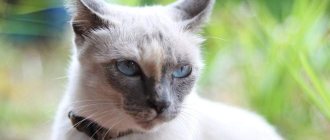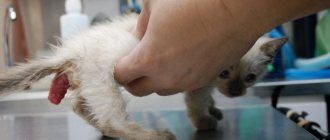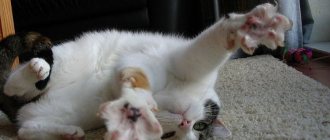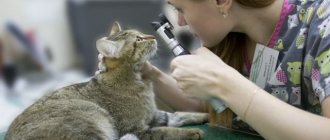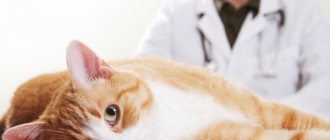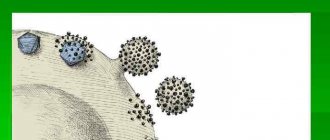What is microsporia in cats: information about pathology
Microsporia in cats is a separate fungal pathology, usually caused by a fungus of the species Microsporum Gypseum, sometimes by other representatives of the genus Microsporum. The problem is that in practice all pathologies caused by pathogens from the genus Trichophyton are also called the same.
In fact, they cause a separate disease called trichophytosis. To the eye (and in many other ways), the differences between these two diseases are so minimal that in practice, veterinarians usually call all these diseases dermatophytes, without making any special distinctions between them.
There is one more important nuance concerning the same Microsporum Gypseum. Scientists are still arguing about its exact species specificity, but there is little sense in this: it is known for sure that this parasitic fungus can affect not only cats, but also dogs, chinchillas, rabbits, other domestic and wild animals, as well as humans. The worse the potential host’s immunity, the greater the chance of infection.
Interesting! The feline variety of this disease is considered the most unpleasant. The reason is the increased virulence and infectiousness of the cat strain.
For example, the canine strain of the pathogen is not that dangerous for humans (albeit with reservations), although just one contact with a sick cat (which may well not have signs of the disease) results in infection with a probability of about 70%.
Treatment of ringworm in a cat by specialists from the Rostov-on-Don clinic
Since fungal spores are very tenacious and sticky, treatment can take a long time. The fungus very easily clings to various surfaces, while remaining unnoticed. For this purpose, doctors at the Rostov-on-Don clinic recommend thorough disinfection of all kinds of objects to which the infected pet had access. It is very important to adhere to the rules of personal hygiene.
Is ringworm transmitted to humans, you ask? The answer will be unequivocal - yes, it is transmitted. Wash your hands thoroughly and be sure to use sterile gloves.
Veterinarians at the Rostov-on-Don clinic treat lichen in cats with special antifungal medications (ointments, sprays). Some veterinarians use the vaccine to prevent and treat lichen, however, this is a controversial issue that remains open today. If serious damage to the epidermis is diagnosed, the penetration of fungal spores into the outer layer of the pet’s skin, antibiotics must be prescribed. They stop inflammatory processes. Do you have any questions or doubts? Do you urgently need experienced treatment for lichen? Our veterinarians at the Rostov-on-Don clinic will share their many years of experience. Contact us - we are always in touch. Our effective treatment will quickly eradicate shingles from your pet.
Basic differences between microsporia and trichophytosis
As we have already written, the differences between microsporia and trichophytosis are small, but they still exist:
- With microsporia, the parasite lives on the surface of the hair, while with trichophytosis it affects the hairs from the inside.
- Microsporia can usually be diagnosed using a Wood's lamp, while fungi of the genus Trichophyton usually do not reveal themselves under UV radiation.
- Unlike trichophytosis, microsporia is usually accompanied by quite severe itching.
It should be noted that the differences listed above are not very specific, and in practice the difference between diseases becomes even more blurred. The only 100% difference is the location of the pathogen (on the fur/inside the hair).
Danger of infection
Microsporia in cats can lead to infection in humans. Young children and elderly people are at greater risk. Therefore, if you suspect lichen, you should protect the animal from strangers, and the person caring for the cat must take all precautions.
When handling your pet, you must wear protective gloves. All animal habitats must be disinfected. If there are other animals in the house, veterinarians recommend vaccinating them. However, not all experts consider the injection to be effective, but still the benefits of vaccination are greater than the harm.
Symptoms, initial stage and first signs of microsporia in cats
Owners need to remember that the symptoms, initial stage and first signs directly depend on what particular form of microsporia their pet has developed.
But it is still possible to identify the main symptoms, which are typical for all forms of the disease:
- A sudden and inexplicable change in the condition of the cat's fur. With microsporia, it can become rarer, stiffer, brittle and unpleasant to the touch.
- You can see a grayish coating on your pet's fur. True, this only works in the case of light-colored cats, as well as completely black pets.
- The cat becomes restless and itches often.
- Bald patches on a cat's body. In mild cases or in the early stages, they usually appear on the face, ears, chin, as well as on the abdomen and genital area.
- The skin of a sick cat begins to peel off and even become scaly.
- There are no signs of severe inflammation in the bald areas, but they gradually grow. If you look closely, the skin in these places is literally strewn with “stumps” of hair broken off at the root.
- If left untreated, the cat becomes completely bald, covered with scales and scabs, and wounds and ulcers appear on its skin, which are quickly contaminated with pathogenic microflora. Not all cats survive to this state, since the animal usually dies much earlier from sepsis or secondary infections.
Surface form
The easiest and most common option. In this case, bald patches with hair stumps quickly appear on the cat’s skin. As a rule, the process develops quite quickly, within a maximum of three weeks.
Very often, the skin of a sick cat is infested with pathogenic microflora, which is why pyoderma and other variants of purulent inflammation of the skin are not uncommon.
Deep, follicular microsporia
The most severe version of the disease. Fortunately, it doesn't happen often. But if the symptoms described below appear, the owner needs to urgently take the cat to the nearest clinic:
- Bald patches quickly appear on the skin.
- On bald areas of the skin, ulcers, scabs, and deep wounds form in just as short a time. All these injuries do not heal, but quickly fester.
- Damage has an unpleasant tendency to merge and form peculiar conglomerates. The general condition of the cat quickly deteriorates, and the pet is at great risk of dying due to sepsis.
Hidden microsporia
In cats, this variant is found only slightly less frequently than the superficial form. Microsporia in this variant is extremely insidious, since for a long time the cat does not have any clear clinical signs, but at the same time it is already contagious both to other animals and to humans.
However, with luck and some attention, you can see signs that something is wrong:
- Grayish coating on the fur.
- The animal scratches itself frequently, even if it is wearing antiparasitic collars.
Clinical manifestations characteristic of microsporia can take a long time to develop, sometimes over several months. In addition, this variety often becomes chronic, characterized by periodic relapses.
Erased form
The rarest variety. In fact, in this case the disease is chronic, relapses manifest as the formation of small bald patches and crusts on the pet’s skin. As a rule, there are no other clinical signs.
Of course, in this case too, the pet is contagious to surrounding animals and people.
Signs of microsporia
There are four forms of lichen caused by fungi of the genus Microsporum:
- latent form (typical of strong adult animals, symptoms are subtle);
- erased form (small hairless lesions, unexpressed signs of the disease);
- superficial form (one or more hairless areas, broken hairs, inflammation is barely noticeable or absent);
- follicular form (bright inflammatory process on the skin, crusts, ulcers).
Microsporia usually begins with a small hairless spot on the face, ear, neck, paw or tail. The skin is clean, but seemingly whitish, sometimes covered with barely noticeable grayish scales. The hair around the bald patch is pulled out in bunches, easily and without pain. If treatment is not started, the spot will grow, and new bald spots will appear on the fur coat. When pathogenic flora (bacteria, dirt) enters the skin, it becomes very inflamed and red, itchy, covered with blisters and ulcers.
Remember that some types of mushrooms are dangerous to humans. Even if a latent form occurs, the cat is still constantly shedding active spores! Microsporia, even in mild form, greatly undermines the pet’s immunity.
With an erased and hidden form, a single spot can remain unchanged for years. Sometimes there are no bald patches at all, but the hair looks disheveled, falls out easily (the owner thinks that the cat is constantly shedding), and a grayish coating is noticeable at the base of the fallen hairs. As a rule, dandruff appears, the skin is dry, the fur is dull, and a long-haired cat constantly walks around in tangles (even if you brush your pet daily). Such symptoms are much more difficult to notice than a bald spot, so owners should regularly inspect the coat and monitor the condition of the pet’s skin.
Tests and diagnostic methods
All tests and diagnostic methods are extremely important, as they quickly determine whether a cat has a fungal infection, which is also dangerous for humans. Today, veterinarians around the world use three main methods:
- Wood's lamp. This is a special lamp that uses a UV radiation source as a lamp. A sort of mini-solarium. The essence of his work is that under ultraviolet light, some strains of dermatophytes begin to fluoresce. Accordingly, in cases where a cat’s fur begins to glow, like a neon sign in a store, a positive diagnosis of microsporia can be confidently made.
- Microscopic examination of hair samples and skin scrapings from the boundaries of healthy and diseased tissue. The most common and “simple” method. The complexity of the study prevents us from calling it simple without quotation marks: only an experienced veterinarian will be able to detect the mycelium of parasitic fungi.
- Growing a pathogen culture on a nutrient medium. The most reliable, but complex and time-consuming method. Fungi need a specific and expensive environment, and they grow on it for a long time. Therefore, the technique, even if it produces a 100% result, is used, rather, not to make, but to confirm the diagnosis after the fact.
Treatment options
Treatment of microsporia in cats is complex; therapy includes the use of external medications, systemic drugs, and methods that affect the immune system. Thus, treatment is aimed at all parts of the disease development mechanism (eliminating fungi, increasing immunity).
Of course, if you have symptoms of microsporia, you need to contact a veterinarian for a final diagnosis and selection of a treatment regimen. However, in general, treatment can be carried out at home.
Preparations for external use
For external use, drugs are used whose action is aimed at destroying pathogenic fungi.
Antifungal agents are most often used in the form of ointments. For example, Miconazole, Kubatol. The ointment is applied after preliminary cleaning of pathological skin lesions. First, the skin areas are washed with antiseptic solutions (for example, Chlorhexidine). Then a thin layer of medicinal ointment is applied.
In addition to ointments, special shampoos can be used for external use. For example, Nizoral shampoo. Shampoos are usually used for superficial skin lesions. When starting treatment, it should be taken into account that the course of therapy should be long. In general, treatment should last at least 30–45 days.
Pills
For a deeper process, external application is not enough. In case of deep or widespread form, systemic antifungal drugs should be prescribed.
For the purpose of systemic treatment, drugs such as Itraconazole and Fungivit are prescribed. The advantages of these drugs include more effective action. And the disadvantages are a greater number of side effects, because the drug affects the entire body and is more toxic.
In addition to tablets, the action of which is aimed at eliminating fungi, drugs are also prescribed that reduce skin itching.
Immunomodulators
With microsporia, it is necessary to act not only on pathogenic fungi, but also on the cat’s body (especially the immune system). Increasing immunity has a positive effect on the course of the disease, recovery in this case occurs much faster.
You can increase your cat's immunity using non-specific methods, for example, high-quality nutrition, vitamin supplements, and lack of stress.
Immunomodulators are used medicinally for this purpose. These are drugs whose action is aimed at stimulating the activity of the immune system.
Treatment of microsporia in cats
I would like to immediately note that the treatment of microsporia in cats is a rather lengthy process that requires patience and time. You should not count on a quick recovery for your pets.
Important! If the cat is not treated, the animal will either become a carrier, or the disease will become latent, chronic. It is even more difficult to cure, and all this time the pet will continue to remain infectious to other pets, as well as owners.
It is possible to stop treatment, considering the cat to have recovered, only after a thorough veterinary examination and at least two negative microscopic examinations of the skin and fur.
And further. The medications used in the treatment of severe and advanced forms of the disease are very “severe”; their long-term use is fraught with the development of problems with the kidneys and liver. Therefore, it is better not to let things get to this point, starting treatment for microsporia immediately after diagnosing the disease.
Approximate treatment plan
The treatment regimen below is just an approximate one, it needs to be modified for each specific case, taking into account the characteristics of a particular animal (consultation with a veterinarian is also required):
- First, the pet is prepared for treatment. To do this, you need to carefully trim the hair around the lesions. If the cat has long hair, it is generally advisable to trim it entirely. This measure will greatly facilitate mandatory medical procedures, including the application of ointments and other antifungal drugs.
- Apply antifungal ointments to both the affected areas and the skin around them. It is necessary to capture at least a centimeter of healthy tissue. This will prevent further spread of the pathogenic fungus. Ointments must be applied daily.
- Sick cats must be washed with shampoos with antifungal and keratolytic effects. This allows you not only to destroy the pathogen, but also to cleanse your pet’s skin of crusts, scabs and scabs. This is not done for the sake of improving the appearance of the pet (although for this purpose too): it is easier to apply medications to clean skin and they act much faster. As a rule, in the initial stages of treatment, washing should be done every three days, and subsequently the frequency of treatments can be reduced to twice a week.
- Antifungal agents are prescribed in the form of injections or tablets for oral use. The frequency of their use is determined by the veterinarian. You should not do this yourself, as you can easily poison your pet.
- If the case is severe and the pet will have to be treated for a long time, he must be prescribed multivitamins and immunostimulants. This will keep the cat healthy and speed up the normalization of its condition.
Medications
We list the main drugs used by veterinarians in the treatment of not only microsporia, but also trichophytosis and other dermatophytes:
- Ointment Yam. The drug is “simple”, it has a not very pleasant smell and an extremely sticky consistency, which is why letting a cat smeared with it on the sofa or bed is not the best idea. But the medicine is cheap and quite effective. For microsporia, use it at least three times a day, generously lubricating the lesions on the skin.
- Ivamerol. A product that has gained special recognition in recent years from many veterinarians and cat lovers. Before use, the drug solution is diluted in water (preferably boiled and settled) in a ratio of 20 ml of the composition per liter of water. The amount of mixture is calculated in such a way that it hides the cat seated in it up to the neck. Exposure duration is at least five minutes.
- Intraconazole-based products. Prescribed in a dose of 10 to 18 mg per kilogram of the cat’s live weight (at the discretion of the veterinarian). Since these medications negatively affect the liver of animals, hepatoprojectors (Essentiale-Forte and the like) are additionally prescribed.
Folk remedies
In general, we would not recommend using folk remedies for microsporia, especially in severe cases. They are not particularly effective, but they can easily trigger and complicate the disease. But still, for superficial microsporia, the following is sometimes used:
- A mixture of tar and laundry soap in a 1:1 ratio. First, the “raw materials” are grated on a fine grater and slightly heated in a water bath to obtain a semi-liquid slurry. It is applied to the lesions (but the composition should not be hot) three times a day. Exposure time - 15 or 20 minutes. If signs of irritation appear, the exposure period is reduced to 6-7 minutes.
- Birch tar, but in the case of cats its use is contraindicated. If there are no alternatives at all, a small amount of tar is applied to the affected areas of the skin for 15 minutes, and at this time a surgical collar is put on the animal or held so that the cat does not lick the smeared areas. Then the tar is thoroughly washed off with warm water and baby soap. If your pet gets tarred, it may die.
- Alcohol tincture of iodine. They lubricate the lesions twice a day.
How is microsporia treated?
Treatment is recommended only under medical supervision. It will take about a month and a half to completely cure a cat of fungus. When the first symptoms appear, you should not start treatment yourself at home, but should consult a veterinarian, since in the early stages the disease is treated faster and easier. Do not treat affected areas before visiting a veterinary clinic.
The veterinarian will shine a special lamp on the animal’s skin and fur (a Wood’s lamp produces ultraviolet light, under its influence the fungi are illuminated light greenish). Then the doctor will take the first scraping to determine the type of fungus and the degree of its sensitivity to drugs.
Treatment of ringworm in cats must be carried out comprehensively, and it is necessary to treat areas infected with the fungus at home and give the animal prescribed medications. It is rarely possible to cure the fungus with ointments alone; such treatment can only be prescribed for a very small kitten, for whom the use of stronger medications may be dangerous.
The doctor usually prescribes:
- for local treatment of ointments Miconazole, Exoderil, Mycoseptin, or sprays Zoomikol, Kubatol. You can wash the animal with an antifungal shampoo, for example Nezopharm, Nizoral;
- For internal use, Itraconazole, Griseofulvin, Nystatin, Fluconazole are prescribed.
Microsporia and trichophytosis in cats are most often treated with Itraconazole. Treatment of the animal is carried out at home, but medications should only be given as prescribed by a veterinarian.
Some drugs used to treat fungus in humans are deadly to cats.
The hair around the bald patch or spot must be cut off and the area wiped with a swab previously soaked in soapy water or an antifungal solution. Then apply ointment to the infected area. Make sure that the cat does not lick the ointment; if necessary, apply a protective bandage.
Tablets or capsules must be used as prescribed by a doctor. In case of severe itching, medications are prescribed to reduce it (Stop Itching suspension). For severe inflammation, antibiotics are prescribed. Be sure to use immunostimulating drugs, vitamins and drugs to support the liver.
The veterinarian can offer vaccination; vaccines such as Polivac and Microderm are used. It is very important to carry out treatment at home exactly as prescribed by the doctor, not to interrupt it, not to cancel or replace medications. It is impossible to make sure on your own that an animal is healthy. To do this, you will need to re-analyze the cat's skin scraping for the presence of fungus.
We recommend reading: Treatment and prevention of lichen in cats
One of the most harmful fungal skin diseases is lichen. And the most harmful of all lichens is microsporia. Fortunately, in recent years, microsporia in cats has become less and less common, but this circumstance lulls the vigilance of owners. How to recognize an insidious enemy? How to quickly and without consequences rid your pet of this disease?
Caring for a sick cat
Caring for a sick cat is no different, but... With microsporia, the main rule of care is to make sure that other pets and people themselves do not suffer. Therefore, the following rules must be observed:
- If the cat has long hair, then, as we have already said, it needs to be cut. All wool must be collected and burned to prevent the spread of infection.
- A sick pet needs to eat well and properly (to prevent “sagging” immunity), and therefore it is either transferred to high-quality “natural” food or holistic food.
- To prevent the spread of infection throughout the apartment, we highly recommend limiting the movements of a sick cat to one room. And, by the way, it is necessary to carry out wet cleaning every day, and ideally even carry out quartz treatment.
Pathogen
Microsporum spores are ubiquitous. A cat whose entire life is spent in an apartment becomes infected with microsporia from the owner, who brings fungal spores on the soles of his shoes. Spores can wait in the wings for years and, under stress, infection, vaccination, or exacerbation of permanent diseases, become active, germinate and feed.
recommended articles:
- Grooming a cat, is it worth using scissors?
- Papillomas and warts in cats
The hunting instinct can fail a successful predator cat: mice are a reservoir of infections, including Microsporum.
Fungal dermatitis
Vaccination and vaccines as a way to prevent and treat microsporia
Since the disease we are describing is quite dangerous (including for humans), scientists have long been researching the possibilities of preventing it. This is how vaccination and vaccines against microsporia appeared. They are unique in that you can vaccinate not only healthy cats, but also already sick cats (i.e., these vaccines can act as medicine).
Domestic experts recommend using the following varieties:
- Polivak-TM. Dose – 0.6 ml per administration. For prevention, vaccination is necessary; during treatment, it is repeated after two weeks.
- Vakderm. Dose: 0.5 ml per cat. Unlike the previous drug, revaccination is mandatory after two weeks (regardless of the purpose of using the vaccine).
Both products do not provide 100% protection for your pet from microsporia, but they significantly reduce the risk of developing severe forms of it and significantly speed up recovery.
Prevention
Antifungal vaccines against microsporia - Microderm or Polivak-TM, according to the instructions from the manufacturers, have a preventive and therapeutic effect. Vaccines do not provide 100% protection and are not used outside the Russian Federation.
Quarantine measures for dermatophytosis have been developed for cat nurseries and shelters.
We invite you to join our Zen channel and group on VKontakte or Odnoklassniki, where new articles for pet owners are published.
Similar articles:
- If your cat has food allergies
- Ringworm Caution: What Pet Owners Need to Know
- Why are cats overweight?
Prevention of microsporia
All prevention of microsporia is as follows:
- If the area is unfavorable due to illness, you should not let the cat go outside again, thereby protecting it from contact with stray animals.
- For walks on the street, it is better to use a harness that will prevent the animal from running.
- Your pet should be vaccinated against microsporia at least once a quarter.
- Do not develop other diseases that lead to a severe weakening of the immune system.
Symptoms of microsporia
The main symptom of microsporia is characteristic skin rashes. In the zone of penetration of the fungus into the skin, a red spot with raised edges appears. As the pathogen multiplies, it expands and looks like a ring. Inside the rash, the skin is of a normal or pale pink color, covered with a powdery coating or peels off with peeling crusts. There may be reddish bubbles or nodules along the perimeter of the spot. Moderate itching of the skin in the area of the rash is possible. With massive seeding, several spots appear at once, which merge with each other over time. Most often, rashes appear on the arms, forearms, shoulders, neck, and legs. When infected from animals, the hairy areas of the skin on the head are affected. The affected hair breaks off at a distance of 3-5 mm from the surface of the skin, leaving behind “stumps”. As the fungus spreads, rounded areas of baldness form on the child's head. The area affected by the fungus may itch. Local immunity is impaired here, so secondary infection of the foci with the development of inflammation is possible, incl. purulent. Children often scratch the affected areas, causing the skin to become wet.
Disinfection of living quarters
In order not to become infected yourself and not to endanger your family, you must always remember: high-quality disinfection of a living space is the key to health.
You need to do the following:
- The room with a sick cat is wet cleaned daily. At the same time, “killer” amounts of chlorine bleach are added to the water. Since cats do not like chlorine, after this everything is washed off with clean water and the room is ventilated.
- The floors in the house are vacuumed regularly. After this, it is advisable to burn the dust collection bags, and wash the containers of vacuum cleaners with water cleaning with the same chlorine-containing products.
Reviews
Ringworm in its advanced form is very difficult to treat, but this is not a death sentence and we must definitely fight. The Polivac vaccine did not help my cat, the Itracon capsules did not help, he only developed severe hepatitis and he almost died. Due to the treatment of hepatitis, they temporarily stopped treating lichen, the liver failed and the cat was actually dying, there was no time for lichen. For 3 months, about 25–30% of the cat’s skin was damaged and scratched, everything was covered in bloody wounds and scabs, it was constantly itching. I put on a sweater so that I would comb my hair less. After hepatitis, there was no talk of any medications or ointments; only Imaverol was allowed. After 2 days for 3, I smeared it not on the whole cat, but only on the lesions and around them, and on the doctor’s advice I diluted it not 1:20, as written in the instructions, but first for about a month I diluted it 1:5, then 1:10 . At the beginning of treatment, she was given the immunostimulant Cycloferon in parallel. I was treated for 2.5 months, the first month it generally seemed to me that the lesions were only growing and nothing was helping. After about a month, new lesions stopped appearing and gradually began to heal, the scabs fell off and became overgrown with hair. The fur, of course, was in terrible condition after that, I was pierced with vitamins Gepavi-kel and Tetravit and the cat was transformed before our eyes, now he is a fluffy handsome man. I vacuumed and washed the premises, but didn’t really treat them; it’s simply impossible to treat them properly at home. Don't give up and don't despair, everything will work out for you.
Svetlana
https://forum.ua-vet.com/viewtopic.php?f=23&t=52776
When we were covered with a fungus, Griseofulvin helped us. It may seem too harsh to some, but we didn’t come to him right away either, it’s a pity they didn’t tell us about him earlier, and so we had to feed the entire herd with Griseofulvin. But the results were noticeable after about the first week. Give 1/6 tablet once a day. Those who have not become infected can take it for a week; patients who are sick need a course of 3-4 weeks, even if everything goes away in 1-2. But Fungin is still not worth it for a small kitten, he is very vigorous, the kitten can puke on him and, excuse me, he can vomit... Isolate the small one if possible. Well, wash the apartment with some special means, or just vinegar water.
sanguiss
Use of antifungal ointments
The very unpleasant appearance of the animal is confirmed by photographs of microsporia in cats. Treatment involves the use of antifungal ointments. They give a noticeable effect, but it is necessary to use them according to the exact scheme proposed by a specialist. The most prescribed ointments are the following:
- "Clotrimazole". Has a pronounced antifungal effect. It is necessary to treat the affected areas three times a day. The course of treatment is two weeks.
- "Mikozon." Completely destroys pathological spores and affects secondary microflora. Treatment involves long-term use. The ointment must be applied twice a day. The course is calculated by the veterinarian based on the degree of exposure.
- "YAM." Ointment with an antiseptic effect. Thanks to its astringent consistency, it softens crusts and significantly reduces itching. The drug only needs to be applied for a week. After a course of treatment, healthy hair begins to grow at the site of the lesion.
Veterinarians often recommend preparing the skin before applying ointments. For this, special solutions are used.
We invite you to familiarize yourself with: Metabolism in the body of cattle when feeding mixed feed containing dry brewer's grains
What is lichen
Feline ringworm is a common disease caused by fungi or viruses that affects the fur, skin and claws of animals.
The infection is most often caused by dermatophytes of the Microsporum and Trichophyton species. Therefore, the disease is called microsporia, trichophytosis or dermatophytosis in cats.
Most often identified:
- Dermatophytes Microsporum canis - transmitted by contact with other animals.
- Microsporum gypseum - infection occurs upon contact with the ground.
- Microsporum mentagrophytes are transmitted by rodents.
If the skin, hair and claws are affected by non-dermatophyte fungi, the disease is classified as dermatomycosis in cats.
Depending on the fungus, the types of lichen in cats, symptoms and treatment are divided.
The collective name for fungal infection is dermatophytosis. There is also an unofficial concept - ringworm. When the skin and fur are affected, the hairs become brittle. The rods break off almost at the base, a bald spot appears and it seems that the cat has been shorn in this place. Hence the name.
Ringworm is a self-healing disease. Thus, short-haired cats and animals with strong immunity recover on their own within 3 months. In long-haired breeds, self-healing is possible, but only over a longer period - from 1.5 to 4 years.
If an animal develops lichen and then disappears, this does not mean that the cat is healthy. On the contrary, it can be a source of infection.
Vaccination
Microsporia is quite common in cats. The photo shows how unpleasant the disease looks. Your doctor may recommend vaccination as treatment and prevention. Despite the fact that not all experts consider this technique to be effective, the injection can still protect the pet from the rapid proliferation of the fungus.
The most well-known antifungal vaccines are Polivak. The instructions state that the drugs not only have a preventive effect, but also have an effective therapeutic effect.
However, any veterinarian will not give a 100% guarantee that the vaccine will protect your pet from infection. It is also a known fact that this method is not used in European countries.
Other signs of lichen
Ringworm in cats can also show other symptoms:
- acne, furunculosis;
- fistulas;
- dermatitis with crusts and pustules;
- the animal's fur becomes matted, greasy, and dandruff appears;
- redness and peeling of all skin on the body;
- nail infection with fungus (onychomycosis).
Symptoms of dermatophytosis and dermatomycosis in cats can also appear in an atypical form, looking as if it is fraying of the fur or a bruise.

